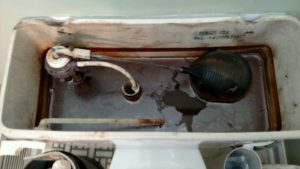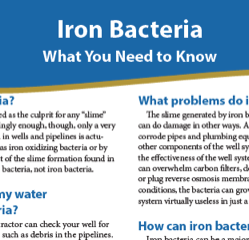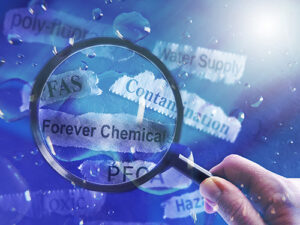Understanding Iron Bacteria
Iron Bacteria is a common issue for homes with well water. The bacteria “slime” is not a health hazard but it can cause other problems.
Iron Bacteria are small living organisms that naturally occur in soil, shallow groundwater, and surface waters. These nuisance bacteria combine iron and oxygen to form deposits of “rust,” bacterial cells, and a slimy material that adheres the bacteria to well pipes, pumps, and plumbing fixtures.[1] While Iron Bacteria is not known to cause disease, it does produce undesirable effects to a well and the water it produces.
To prevent Iron Bacteria, start with a clean slate. The equipment used in well-drilling can cause contamination if it is not sanitized properly. In areas with iron present, it is still likely to have Iron Bacteria in the well. Additionally, most private wells require ongoing maintenance to prevent Iron Bacteria growth. Most home water treatment systems are designed to remove ferrous and ferric iron, but do not address treatment of he Iron Bacteria. There are a few, There are a few treatment units like the Hague Watermax, that can be configured to treat iron bacteria.
What are the Effects of Too Much Iron?
Iron’s positive effects on the human body are widely known. When iron levels become too high, it can cause serious problems. This can be especially common in well water that is not treated for Iron Bacteria.
This list provides more information:
- Clogging: The build-up of residue from Iron Bacteria in pipes can cause serious plumbing problems. A clogged pipe can develop a leak over time. In addition to the damage from leaks, clogging will create issues with water flow at receptacles such as faucets and hose bibs.
- Skin Damage: If iron is a good source of energy inside the body, then it should be beneficial outside as well. Unfortunately, the former statement is untrue. Iron residue in water can damage healthy skin cells. The residue or soap scum builds up on the skin and clogs pores that play an important role in healthy skin.
- Health: As mentioned above, iron is an excellent source of energy inside the body. Iron helps build the red blood cells that transport oxygen from the lungs throughout the body. Excessive amounts of iron, however, can cause digestive issues like nausea and vomiting. The USDA recommends that women between the ages of 19 and 50 get 18 mg of iron a day, while women ages 51 and older and men 19 years and beyond need 8 mg a day.[2]
- Staining: Have you ever wondered why there is a reddish-brown stain in a sink or toilet bowl? Iron in water leaves residue on everything, causing unsightly red or orange stains.
- Food and Drink: Finally, preparing foods with water that has too much iron can produce a metallic taste. The same is true about the metallic flavor of water that has too much iron.
For more information about Iron Bacteria, the National Groundwater Association published a “What You Need To Know” guide. The guide is a recommended resource for well owners.
View or Download the guide here.
What’s the Next Step?
If you’re having problems with your well water, then contact your local water treatment company for a FREE WATER TEST. A trusted water treatment professional can correctly assess your problems and determine if Iron Bacteria is one of them.
[1] http://www.health.state.mn.us/divs/eh/wells/waterquality/ironbacteria.html
[2] https://www.health.harvard.edu/blog/healthy-diet-key-getting-iron-need-201502127710






